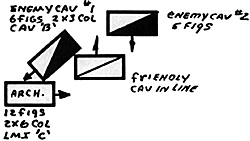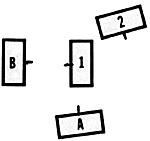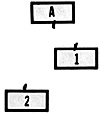NOTE: While many of these questions were answered by Phil Barker, some were answered by Rod Burr, also a recognized expert with the rules.
Q.1: When changing orders of a unit by a general can the entire code be changed? (movement, action, missle). Or only one or some of these? Please explain. Can it be changed in the 1st 3 periods?
A.1: The entire code can be changed. The total code combined is the units "orders". The period of the game does not affect this although movement orders have no effect except chain of command after turn 3. (Burr)
 Q.2: Is it possible to mass missle fire by friendly forces at a
specific point or target (see figure below)? How would you write
your orders so that, say, 3 of your own missle units concentrate
their fire on only one of your opponents?
Q.2: Is it possible to mass missle fire by friendly forces at a
specific point or target (see figure below)? How would you write
your orders so that, say, 3 of your own missle units concentrate
their fire on only one of your opponents?
A.2: Shooting is determined according to the priority list on page 35. The priorities are resolved on a figure by figure basis, so that if all three enemy units were equally qualified under priorities 1-4 each figure would be required to shoot at the nearest enemy body to it. Proper choice of target priorities (e.g. E = Elephants) can allow more effective concentration of fire. Note target priorities are #4 in the list and hence override 5, nearest enemy. (Burr)
Q.3: In a reaction test and a unit is routing, does it deduct a -1 for itself retiring as well as the -3 for routing? If so, this would seem like a double penalty.
A.3: Routing unit does not deduct - 1 for itself retiring. in the long definitions on pages 24-25 the full description is: -1 "for each OTHER friendly body ... retiring". Always check full rules in book when pull outs are unclear. (Burr)
QA: While moving routing units initial period and subsequent periods of rout, do we still consider such restrictions as terrain and formation changes, or do we simply move them away at full charge speed and forget the rest? Please explain, this seems to be a major change from the previous 5th edition. 1st turn uses evade, then what?
AA: Routing units pay all normal terrain movement penalties, the only formation changes allowed to routing units are to "narrow" the unit to pass a gap and to expand after doing so. See page 30, Formation Changes #2, for details. Changes of direction are at normal cost with the routers counting disordered (cause 7) until rallied.
Q.5: When troops are brought in from a flank march. How is this executed? Do they have to all be able to move on the table the same turn (especially when physically not able)!? Can they-be brought on in an elongated column? If so, how? And if this flank march also gets a normal move as well, where is their starting point?
A.5: The units arrive in formation as determined by the owning player. The front rank of the leading unit measures its movement from the edge of the table. All following units deduct the amount they are behind the leading rank from their initial moves. This may result in units arriving on the table on a later turn than the leading rank. It is not necessary to dice again for arrival.
 Q.6: We had a situation come up in a battle recently concerning
how to decide what happens when multiple results apply from
aftercombat decisions. Here was the situation. An archer unit was
caught in changing its formation not in time to face a mounted foe.
Thus the archer unit received casualties without being able to reply.
Enemy cav. #1, who had charged the archers were caught also in
the flank by a friendly cav. unit. Thus it also was not able to reply to
that charge. Enemy cav. #2 did at the same time charge the friendly
cav. meeting it headlong. Please tell us how this mass melee would
work out? None of the charges were impetuous and none broke from
initial charge/countercharge declarations. Loses post melee were;
archers10, friendly cav-11, enemy cav. #1-13, and enemy cav. #2-
10. All troops were regulars.
Q.6: We had a situation come up in a battle recently concerning
how to decide what happens when multiple results apply from
aftercombat decisions. Here was the situation. An archer unit was
caught in changing its formation not in time to face a mounted foe.
Thus the archer unit received casualties without being able to reply.
Enemy cav. #1, who had charged the archers were caught also in
the flank by a friendly cav. unit. Thus it also was not able to reply to
that charge. Enemy cav. #2 did at the same time charge the friendly
cav. meeting it headlong. Please tell us how this mass melee would
work out? None of the charges were impetuous and none broke from
initial charge/countercharge declarations. Loses post melee were;
archers10, friendly cav-11, enemy cav. #1-13, and enemy cav. #2-
10. All troops were regulars.
A.6: Assuming no additional missile fire casualties the results are as follows:
Friendly Archers: Stand and become shaken, not pushed back because not 1 casualty per figure in unit.
Enemy Cav. #1: Pushed back. Received 13 to 11 inflicted which is 1 per figure, but not 2 to 1. Will rally back next turn because not followed up.
Friendly Cav.: Stands in melee with enemy cav. #2. In- f I icted 23, received 11.
Enemy Cav. #2: Stands in melee. Inflicted 11, received 10.
Next Turn: Friendly Cav. and enemy Cav. #2 continue melee unless either breaks off. Friendly archers rally forward. Enemy Cav. #2 rallies back.
Q.7: Do gullies or scrub count as unfriendly cover, since they are capable of concealing troops?
A.7: No.
Q.8: Do (a) troops appearing from a gully or (b) Ll appearing or shooting from scrub cause surprise penalties or reaction checks?
A.8: (a) Yes; (b) No.
Q.9: Under what circumstances are troops concealed within a gully visible (e.g. from within 20 paces or higher elevations, etc.)?
A.9: Treat edge as a h i I I crest.
Q.10: Can troops beyond Ll concealed in scrub be seen normally?
A.10: Yes.
Q.11: According to the description of gullies under Choosing Terrain page 16, wheeled vehicles can only enter and exit at ends of road descents. Under the description of Difficult Terrain, movement across a gully is practical only for troops on foot. Does this mean that therestrictions on wheeled vehicles also apply to mounted troops, etc. ?
A.11: No, a gully crossed by a road is road movement. Vehicles can travel along a gully.
Q.12: When a terrain feature which counts as more than one piece is placed, is it diced for as a single feature? E.g. Would a 1000 pace gulley be diced for as one gully, and thus only require a normal roll rather than the 6 for additional gullies.
A. 12: Yes.
 Q.13: Must the declared target of a charge (a) be a single unit or
body, or (b) may multiple units/bodies be declared as the target if
they can be reached simultaneously by the charging body. (c) In the
diagrams below, alphabetically designated units are from the side
declaring the charge, numerically designated units are the opposing
side. Which of the charge declarations are valid?
Q.13: Must the declared target of a charge (a) be a single unit or
body, or (b) may multiple units/bodies be declared as the target if
they can be reached simultaneously by the charging body. (c) In the
diagrams below, alphabetically designated units are from the side
declaring the charge, numerically designated units are the opposing
side. Which of the charge declarations are valid?
A.13: (a) No; (b) Yes; (c) Any.
Q.14: In diagram ii above, (a) if unit 2 was not an explicitly declared object of unit 'a's' charge, would unit a count as being charged by a third party (and hence have to cancel its declared charge) if unit 2 declared a charge against unit 'a'? (b) Alternatively, would unit 2 count as being charged by unit 'a' since it would be moving into the path of unit 'a', thus causing both units to check for charging but using the testing in response to charge results.
A.14: (a) Yes; (b) No.
 Q.15: In the diagram at right, if unit 'a' declared unit 1 as the target
of its charge, unit 1 declared unit 'b' as the target of its charge, and
unit 2 declared unit 'a' to be the target of its charge, which units
would have charges cancelled, and which morale result column
would each unit use? Assume all units have a final reaction test in
the range charge/make any response orders permit.
Q.15: In the diagram at right, if unit 'a' declared unit 1 as the target
of its charge, unit 1 declared unit 'b' as the target of its charge, and
unit 2 declared unit 'a' to be the target of its charge, which units
would have charges cancelled, and which morale result column
would each unit use? Assume all units have a final reaction test in
the range charge/make any response orders permit.
A.15: 'a' cancelled,- 1 & 2 charge. If 2 fails charge test then 'a charges and 1 is cancelled.
 Q.16: In the diagram at right, unit 'a' has declared a charge against
unitl which is LI with hold orders. Unit 2 of ILMI has declared a charge
against unit 'a' and plans to interpenetrate the ILI to reach unit 'a'. All
reactions are in the range charge/make any response orders permit.
Unit 'a' moves fast enough to contact unit 1 (LI) before unit 2 has time
to complete interpenetrating unit 1. Will unit 2 then count as replacing
unit 1 in combat and hence unit 'a' will only fight unit 2. Will unit 2 be
unable to complete interpenetration and hence unit 'a' will only fight
unit 1. Or, will unit 2 end up intermingled with unit 1 so that unit 'a' will
fight parts of both units. If unit 1 counts as replaced in combat, will
unit 2 be disordered due to interpenetrating a unit which has moved
just enough to be replaced in combat.
Q.16: In the diagram at right, unit 'a' has declared a charge against
unitl which is LI with hold orders. Unit 2 of ILMI has declared a charge
against unit 'a' and plans to interpenetrate the ILI to reach unit 'a'. All
reactions are in the range charge/make any response orders permit.
Unit 'a' moves fast enough to contact unit 1 (LI) before unit 2 has time
to complete interpenetrating unit 1. Will unit 2 then count as replacing
unit 1 in combat and hence unit 'a' will only fight unit 2. Will unit 2 be
unable to complete interpenetration and hence unit 'a' will only fight
unit 1. Or, will unit 2 end up intermingled with unit 1 so that unit 'a' will
fight parts of both units. If unit 1 counts as replaced in combat, will
unit 2 be disordered due to interpenetrating a unit which has moved
just enough to be replaced in combat.
A-16: 'a' cancelled; 2 charges; 'a' can countercharge but cannot charge 1. However, if 'a' did not say "only", 'a' charges, 2 charges and 'a' fights 1 and overlap of 2.
Q.17: According to the section on the Effect of Difficult Terrain, movement over Abatis is possible only to troops on foot. According to the section on Casualty Inflicting Obstacles, abatis inflict casualties on impetuous mounted troops charging across them. Which of these is correct?
A.17: Both. Nothing says impetuous troops needn't charge troops behind abatis. They take casualties and don't close.
 Q.18: On the previous turn a cavalry unit charged an enemy
infantry unit and neither unit was pushed back. The cavalry unit has
attack orders and the infantry held. The cavalry unit intends to break
off from melee on this turn. If a charge is declared against the cavalry
unit by another enemy unit, may it still break off? Assume none of the
units are impetuous.
Q.18: On the previous turn a cavalry unit charged an enemy
infantry unit and neither unit was pushed back. The cavalry unit has
attack orders and the infantry held. The cavalry unit intends to break
off from melee on this turn. If a charge is declared against the cavalry
unit by another enemy unit, may it still break off? Assume none of the
units are impetuous.
A.18: It responds to the charge if entitled or forced to evade, it breaks off.
Q.19: Two LC units with S orders simultaneously declare charges against each other, and hence use the Testing in Response to charge Results. if both units end up in the range. If S orders, must evade. If H, can't countercharge, what is the result. Do both units (a) make an evade move; (b) both charge; (c) do they both fail the test to charge and hence make normal moves only.
Q.19: (a) Yes,- (b) No; (c) Yes.
 Q.20: According to the section on Sequence of Play, "all
movement is regarded as in theory simultaneous, but playability
considerations make the following sequence mandatory". How will
this effect the following examples.
(a) Unit 'a' is pursuing unit 1 and is impetuous. Unit 2 declares a
charge against 'a'. Assume the lesser of unit 1's route move and unit
'a's' pursuit move is long enough to carry unit 'a' beyond unit 2's
charge if fully executed but unit will be caught in flank if unit 'a's'
pursuit and unit 2's charge are pro-rated and executed
simultaneously. How is this all carried out?
Q.20: According to the section on Sequence of Play, "all
movement is regarded as in theory simultaneous, but playability
considerations make the following sequence mandatory". How will
this effect the following examples.
(a) Unit 'a' is pursuing unit 1 and is impetuous. Unit 2 declares a
charge against 'a'. Assume the lesser of unit 1's route move and unit
'a's' pursuit move is long enough to carry unit 'a' beyond unit 2's
charge if fully executed but unit will be caught in flank if unit 'a's'
pursuit and unit 2's charge are pro-rated and executed
simultaneously. How is this all carried out?
A.20a: 1 makes rout move, 'a' makes pursuit move, 2 charges and fails to contact.
(b) Unit 'a' is cav. which has declared a charge against unit 1 of infantry. Unit 2 is infantry not within its charge distance of 'a'. If movement is prorated and executed simultaneously, unit 2 will execute normal movement and be in unit as path before unit 1 (which is holding), is contacted. Is unit 2 allowed to move before unit 'a's' charge is completed? If so does it check morale for being the target of a charge?
A.20b: (1) Makes response move, (a) charges, (2) makes normal move.
Q.21: In the 30.7.81 rules clarifications/changes, should the modification to page 36, Shooting Combined with Movement or Hand to Hand Combat, Line 2 be "from beyond 40 paces" rather than "from within 40 paces". If the change is correct as written, is it permissible for the rear rank of a charging unit armed with darts to shoot from beyond 40 paces (and hence still be able to fight in melee) while the front rank shoots from within 40 paces. If so, this would not seem to be a significant penalty for the rear rank's shooting since they are halved for shooting overhead anyways.
A.21: We goofed! "Beyond" it is.
Q.22: A Chinese unit is made up of a front rank of MI with Long Thrusting Spears and the rear rank is armed with crossbows. May the front rank choose in the first round of melee or after to use the other weapons factor (e.g. swords) so that the rear rank which can only use swords will be using the same weapons and hence be able to fight with half its figures. The MI is regular.
A.22; no.
Back to Table of Contents -- Courier Vol. V #1
To Courier List of Issues
To MagWeb Master Magazine List
© Copyright 1984 by The Courier Publishing Company.
This article appears in MagWeb (Magazine Web) on the Internet World Wide Web.
Other military history articles and gaming articles are available at http://www.magweb.com